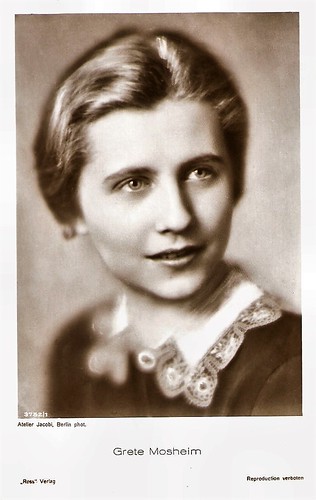
German postcard by Ross Verlag, no. 3752/1, 1928-1929. Photo: Atelier Jacobi.
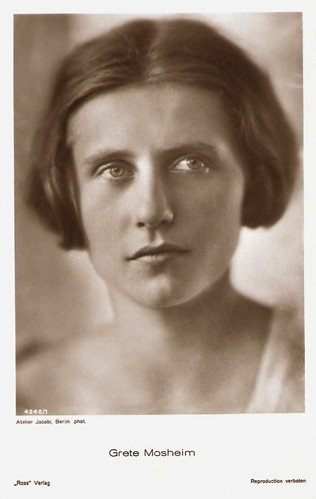
German postcard by Ross Verlag, no. 4240/1, 1929-1930. Photo: Atelier Jacobi.
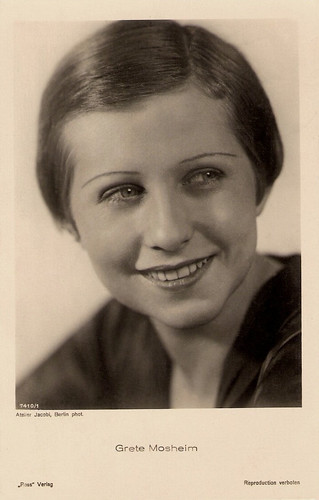
German postcard by Ross Verlag, Berlin, no. 7410/1, 1932-1933. Photo: Atelier Jacobi, Berlin.
A superstar almost overnight
In 1905 Grete Mosheim (originally Mohsheim) was born in Berlin as the daughter of family doctor Markus Mosheim and his wife Clara.
After visiting the Viktoria Lyzeum in Berlin she started her acting career at the age of 17, studying together with Marlene Dietrich at the school of the Deutschen Theaters under Berthold Held in early 1922, as well as at the Reicherschen Hochschule für dramatische Kunst.
Mosheim became established under Max Reinhardt, and - when she was only seventeen - he gave her the chance to substitute in the American play The Speaking Ape when the female lead became ill. Mosheim learned the difficult role from Albert Bassermann in just 24 hours and became a superstar almost overnight. 'Die Mosheim' was a member of the Deutsches Theater, Berlin from 1922 to 1931. From 1931 to 1932 she played at the Lessingtheater, from 1932 to 1933 at the Metropoltheater and afterwards at the Komödienhaus and the Volksbühne.
Mosheim appeared in numerous German films, mostly silent films, starting with Carl Theodor Dreyer’s film Michael (1924) starring Walter Slezak. Subsequent films were Derby (Max Reichmann, Joe May, 1926), Der Geiger von Florenz/Impetuous Youth (Paul Czinner, 1926), and Junges Blut/Young Blood (Manfred Noa, 1926) starring Lya De Putti.
From 1927 on Mosheim had the female leads in Faschungszäuber/Carnival magic (Rudolf Walther-Fein, 1927) opposite Harry Liedtke, Die spork’schen Jäger/The Hunters of Sporck (Holger-Madsen, 1927) with Otto Gebühr, Primanerliebe/Students' Love (Robert Land, 1927), Höhere Töchter/Higher daughters (Richard Löwenbein, 1928) with Gustav Fröhlich, and Die Siebzehnjährigen/The 17-year-old (Georg Asagaroff, 1928). In these films of the late 1920s, Grete Mosheim often represented the popular type of proud and mischievous girl.
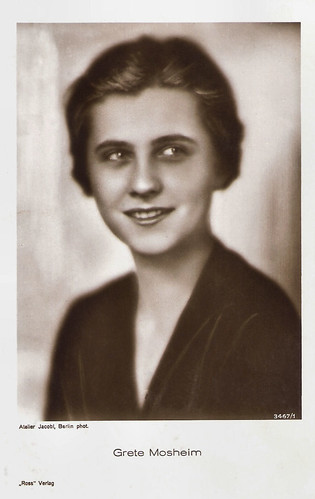
German postcard by Ross Verlag, no. 3467/1, 1928-1929. Photo: Atelier Jacobi, Berlin.
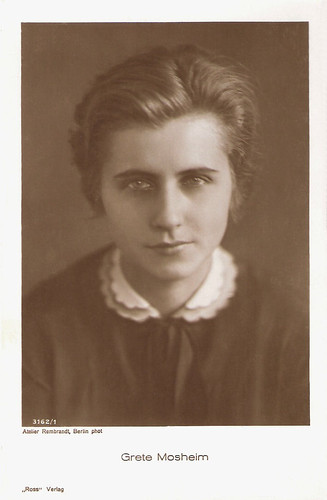
German postcard by Verlag Ross, Berlin, no. 3162/1, 1928-1929. Photo: Atelier Rembrandt, Berlin.

German Postcard by Ross Verlag, no. 5064/1, 1930-1931. Photo: Elli Cahn, Berlin.
Players from abroad
Until she fled Germany in 1933, Grete Mosheim starred in many early German sound films, including a woman who died of a forced abortion in Cyankali (Hans Tintner, 1930). Cyankali criticised the German abortion interdiction, the reason why it was soon forbidden.
In the early 1930s, Mosheim also played Alfred Dreyfus’ (Fritz Kortner) wife Lucie in Dreyfus (Richard Oswald, 1930), the daughter of the main character (played by Werner Krauss) in the period piece Yorck (Gustav Ucicky, 1931), and an audacious steno typist who eventually marries her boss, a banker in Arm wie eine Kirchenmaus/The Church Mouse (Richard Oswald, 1931).
Mosheim was also pre-eminent in the Berlin theatre scene, appearing in a wide variety of roles, and being equally at home in drama and comedy. In 1933 she emigrated to Austria and in 1934 to Britain.
After intensive study, she mastered English well enough to appear in the play Two Share a Dwelling in London in 1934. It became a special success for Mosheim because she met the American railroad king Howard Gould, who had financed the performance, and who became her second husband in 1937.
She also played in the British film Car of Dreams (Graham Cutts, Austin Melford, 1935) opposite John Mills. In 1938 Mosheim accompanied Gould to New York. Acceding to Gould's desire she spend more time with him, she retired from acting for a few years, but in 1941 she returned to the stage and played with Players from Abroad, a German-speaking theatre company she had helped to found.
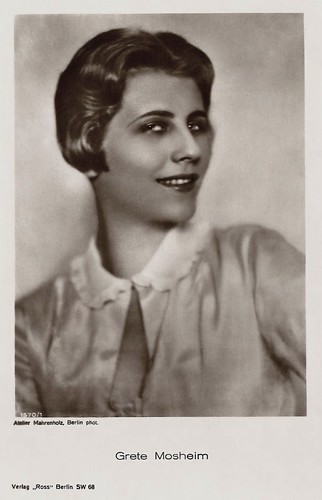
German postcard by Ross Verlag, Berlin, no. 1520/1, 1927-1928. Photo: Atelier Mahrenholz, Berlin.

German postcard by Ross Verlag, no. 4590/1, 1929-1930. Photo: Elli Markus.
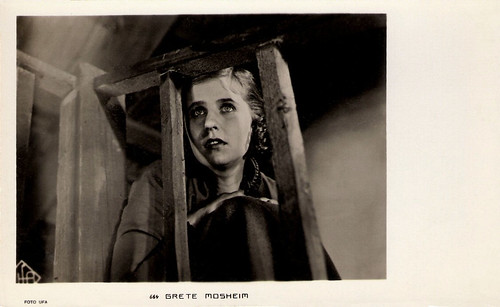
Dutch postcard. Photo: UFA.
Sally Bowles
In 1952 Grete Mosheim appeared in Germany for the first time after the war. First, she appeared in Berlin as Sally Bowles in John van Druten‘s play Ich bin eine Kamera (I am a Camera, 1952), based on Christopher Isherwood's Berlin novels. Later this play would be the basis for the musical and film Cabaret.
In 1963 Mosheim received the Critics Award for performing arts for her part of Hannah Jelkes in Tennessee Williams' play Die Nacht des Leguan (Night of the Iguana) and in 1971 she was honoured with the Deutsche Filmpreis (Filmband in Gold) for her outstanding services to German cinema, plus the Bundesverdienstkreuz in 1974.
After the war, Mosheim hardly played in films again, besides her part as the grandmother in the German teenager drama Moritz, Lieber Moritz/Moritz, Dear Moritz (Hark Bohm, 1978). She did play on German television though, such as in the Rosa von Praunheim TV documentary Underground and Emigrants (1976), and in fiction series such as the episode …wie die Wolfe/Like the Wolves (Wolfgang Staudte, 1970) of the Krimi series Der Kommissar/The Commissioner, starring Erik Ode.
From 1928 until 1933 Grete Mosheim was married to Austrian actor Oskar Homolka – with whom she had played in Die Rothausgasse, Dreyfus and Moral und Liebe (Georg Jacoby, 1933) - but they divorced. In London Mosheim married a second time to American industrial Howard Gould (1937-1947), and a third time to journalist Robert Cooper. She had no children.
Her sister was stage actress Lore Mosheim aka Lori Lahner and Laurie Lane, who had a film career from the early 1930s on, appearing in films like Summer Storm (Douglas Sirk, 1944). Until the end of her life, Grete Mosheim lived in New York and often returned to Germany for theatre performances. She died in New York in 1986 from cancer, aged 81.
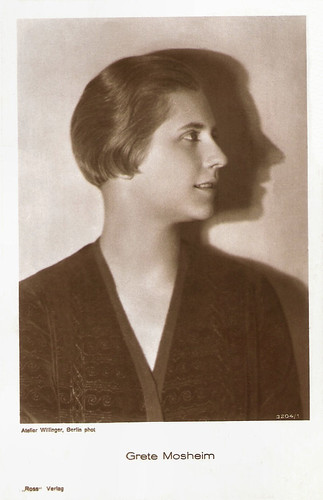
German postcard by Ross Verlag, no. 3204/1. Photo: Atelier Willinger, Berlin.
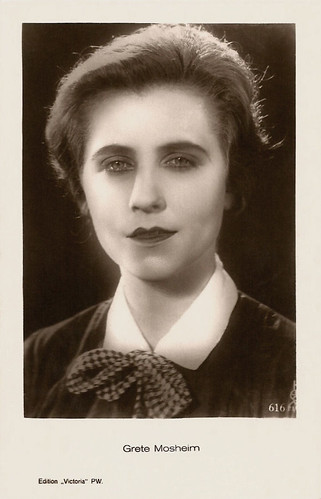
Polish postcard by Edition Victoria PW, no. 616. Photo: Hom-AG für Filmfabrikation. Grete Mosheim in Höhere Töchter/Superior daughters (Richard Löwenbein, 1927).
Sources: Thomas Staedeli (Cyranos), USC Libraries, www.filmportal.de, Wikipedia (German and English), and IMDb.
This post was last updated on 24 September 2023.
No comments:
Post a Comment